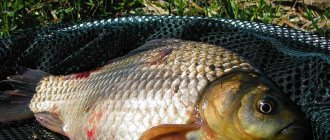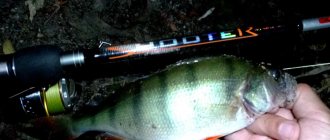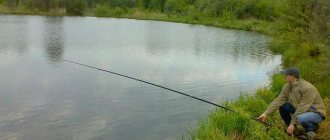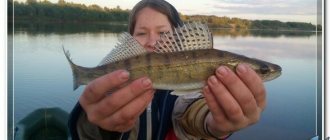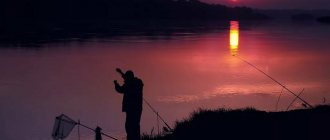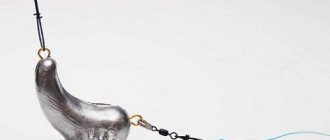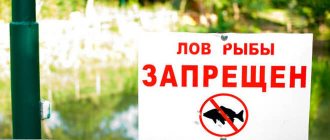Absolutely all fishermen know that influence of pressure on fish biting very high, but few people know about the nature of this phenomenon. What really happens to the fish when pressure increases or decreases, and why does this affect the bite so much? After all, it is clear that this is hardly due to the fact that due to high pressure the fish simply does not have the strength to open its mouth, and therefore there is no opportunity to swallow the bait. Or, conversely, if the pressure is low, then the fish’s mouth completely loses the ability to close and this upsets the fish to such an extent that it becomes unable to bite. Of course, such assumptions are ridiculous. But this does not make the situation any clearer. Then what really pushes the fish when the pressure changes to stop or increase the bite?
The influence of atmospheric pressure on fish biting
Anyone from school knows that in the abdominal cavity of a fish there is an air swim bladder filled with air (in addition to oxygen, it may contain a small amount of nitrogen and carbon dioxide). Filling a fish's swim bladder with air is a very labor-intensive process. The pumping of air into the bladder is provided by gland, which is usually called the red organ, but since there is relatively little blood in the fish body, the process of releasing the oxygen mixture for the bladder itself is very long. By regulating oxygen in the swim bladder, the fish achieves neutral buoyancy, which allows it to stay at different depths without much effort.
Now let’s imagine that the pressure has dropped or risen sharply. The balance of buoyancy is disturbed, as a result of which the fish has to again begin pumping or bleeding air from the swim bladder, and until this process is completed and the fish regains the ability to feel normally in the water at the new established pressure, it will certainly not be able to bite.
Fishermen often talk about the process when a fish has to regulate the pressure in its swim bladder: “the fish is sick.” And this is not far from the truth. Many have noticed that with sudden surges in pressure, a headache often begins. Well, with a headache, what kind of appetite can we talk about? About the same thing happens with fish, the only difference is that a person has the opportunity, with the help of medications, to quickly normalize blood pressure and relieve pain, which cannot be said about fish, which does not have the opportunity to swallow a tablet of, say, ketorol and feel I feel completely fine.
An important factor is that the pressure in the bladder is closely related to the work of such an important organ as the lateral line, which is responsible for the seismic orientation of the fish in the water, which in turn is directly connected to the brain. It is through the lateral line that hydroacoustic signals are received from objects surrounding the fish in the water, as well as from the bottom line and the surface of the water. The brain processes signals emanating from the lateral line, thereby determining the position of the fish’s body relative to certain obstacles, their geometry and distance, and with the help of this it adjusts its position in the aquatic environment.
With a sharp increase in pressure, the fish simply loses its orientation. The control of hydrostatic pressure is disrupted, and the fish begins to consistently adapt to the new pressure. And until this “disease” passes, that is, until the fish regains the ability to navigate well in an aquatic environment with new pressure, a good bite cannot be expected. For comparison, you can also give an example from human life. Let's say you broke your glasses, but your vision is not very good. Everything before my eyes floats and blurs. In this state, you, like the fish, will clearly have no appetite.
Choosing a place to catch pike perch in the fall
When choosing a place to catch pike perch in an unfamiliar body of water, you must, first of all, ignore areas where the appearance of a predator is unlikely. These are places with a silted bottom, muddy water and rapid currents. During the daytime, pike perch is rarely found in shallow water with a depth of up to 1.5 m. But when fishing for pike perch at night, shallow areas should not be ignored.
Signs of promising areas for fishing for fanged predators:
- Sandy bottom with stones, pebbles and other bottom obstacles;
- Depth changes;
- Availability of springs;
- Lack of wildly growing algae;
- Brovki;
- Landfills on the middle reaches;
- Accumulation of narrow-bodied small fish.
The effect of pressure on fish biting in winter
Pressure surges in winter do not differ much in their influence on the bite from the summer period, except that adaptation to pressure changes takes much longer due to the fact that in winter the water is less saturated with oxygen than in summer, and the physiological activity of most species fish in winter is significantly reduced. In winter, it is best to fish after the pressure has stabilized at the same level for 2–3 days. After such a period, the fish are sick and are more likely to be interested in the bait.
The influence of the moon on fish biting
Ice fishing pressure
Ruff: habits and methods of catching
What do pike perch bite on in the fall?
Of the artificial baits, the jig version works consistently, where experts prefer edible silicone.
At this time, the predator’s diet is varied. It’s understandable: zhor. The fanged one can be caught using natural bait: live bait, frog or worm. Of the artificial baits, the jig version works consistently, where experts prefer edible silicone.
The shape of the bait is important. Lures should be placed oblong. It will be easier for pike perch to grab a narrow fish than a wide bream.
Vibrating tails and twisters are not far behind in popularity. It should be borne in mind that when the water temperature drops, they work a little worse. Autumn is a favorable period when passive models are also connected to active baits:
- Rubber worms.
- Slugs.
- Cancers and so on.
When choosing bait, you need to take into account that the fanged one has a narrow throat and a small mouth. Models up to 100 mm long work better. As for colors, you need to experiment. Working colors are considered to be: orange, yellow, light green and brown in light colors.
When fishing in the fall with a spinning rod, foam rubber fish and mandulas are often used. These baits work both on a regular jig head and on its modernized versions (jig rig, Tokyo rig). Trolling enthusiasts specialize in autumn on elongated spinners and wobblers: the minnow variant.
Fishing for pike perch in September
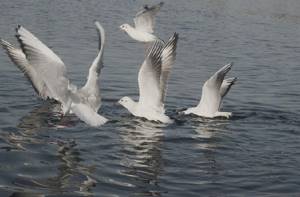
Preparing for winter stagnation, pike perch actively attacks the fry, losing vigilance. During the day, the predator stands in the depths, and at dusk it goes out to hunt, closer to shallow water.
You can catch pike perch in September from the shore, at a bend in the river where there is no current. When fishing from a boat, fish are looked for by a cluster of seagulls. The favorite stopping places for this ambush predator are stone ridges, depth changes, large boulders, and flooded trees.
Recommended reading: How to catch ruffs
What to catch pike perch in October
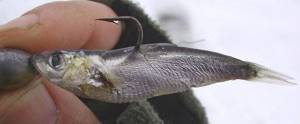
This month is the best time to catch pike perch. The reason for this is the predator's gluttony. You can catch pike perch in October day and night. This month the predator’s bite is quite stable, with only a short-term weakening. In mid-autumn, almost any fishing method begins to work. The fanged one takes on jigs, lead rigs, plumb from a boat, on a donk from the shore, etc.
Note! In October, the probability of catching a qualifying specimen increases significantly. In search of a trophy, moving around a body of water will certainly bear fruit. The pike perch does not stand in one place; it is now busy searching for wintering holes.
Features of fishing in November
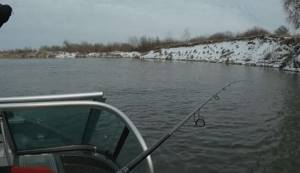
First of all, this is observed in reservoirs and large rivers. The end of October and November is the upper limit of the zander’s zander. This is the last opportunity to accumulate nutrients before wintering. For the most part, at the end of autumn the predator stands at depth. And only when the temperature rises, it occasionally comes out closer to the surface.
It is better to catch pike perch in November with a hard spinning rod. This type of tackle makes it easier to perform aggressive retrieves. The length of the rod depends on the fishing method and is selected independently. Accelerated wiring is important here, as well as a hard, lightning-fast hook.
Balancers, bottom spoons and rattlins are sometimes used as bait when fishing from a boat. In already quite cooled water, trolling and the so-called “predatory feeder” work well for pike perch.
The effect of high pressure on fish biting
It is noticed that after the pressure increases and remains at a constant level for some time, after adaptation, the fish bite increases significantly, with the exception of bottom-dwelling fish, for example, such as catfish. Although bottom-dwelling fish species, as well as predators, are less sensitive to pressure surges and quickly adapt to them, their activity decreases somewhat at elevated pressure. Predators really don’t like the sun and during high pressure they prefer to sit somewhere in shady places or at the bottom. The same cannot be said about white fish, which are simply bursting with activity.
If the pressure constantly fluctuates, then you can completely forget about a good bite. At such moments, the fish is completely disoriented and not only is it not interested in biting, but it will not be able to find the bait at all.
Weather for autumn fanged fishing

On a warm autumn day you can meet him in the late afternoon. Autumn weather is often capricious: calm, wind, lunar phases and atmospheric phenomena. These factors directly affect the behavior of the fanged animal and its activity. With the advent of cloudiness, in the absence of strong wind and precipitation, the activity of the predator increases. The chances of catching a test specimen increase at night as the full moon approaches.
Note! The chances of getting a trophy increase in the period of five to six days before and after the full moon.
At what pressure does pike perch bite best in autumn?
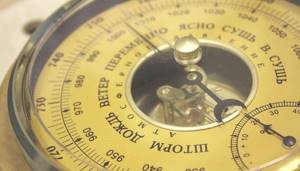
When pressure decreases, fish activity decreases several times. There is virtually no chance of catching a predator before a storm. The cyclone forces the fish to lie low and wait out this unfavorable period.
High pressure saturates the water with oxygen. This helps the fish breathe easier and has more strength to move. At this time, the pike perch has an excellent appetite.
Influence of wind and precipitation
Experienced spinning anglers know that when there is wind, a fanged fish is drawn to the shore like a magnet. It's simple: the wind, washing the coastal edge, creates foam and turbidity, and washes away food. The most important point is the formation of an edge (border) of muddy and clear water.
Recommended reading: Fishing for trout using feeder gear
On a note! With a stable strong wind, pike perch always leaves the holes and tends to the shore. The fry also move to the shoreline in hopes of getting food.
The long-awaited “meeting on the Elbe” takes place between the attacking predator and the potential victim, the fry. Such places are often “shelled” when catching fanged fish with a spinning rod from the shore.
Peculiarities of biting at variable atmospheric pressure
Atmospheric conditions are unstable throughout the day. A sharp change occurs in the summer, when the heat gives way to showers, thunderstorms, and the appearance of strong winds. In addition, daily temperature fluctuations have an impact.
The behavior of individuals also depends on other factors. In summer, the temperature of the water affects more than its change; there are also strong fluctuations. If the conditions in the water are quite comfortable, then, for example, the pike is active regardless of its daily fluctuations.
The water level changes with a sudden change in pressure. If water fluctuations do not exceed 50 cm per day, then the bite will be intense regardless of any changes. But this happens only under one condition - it falls or rises smoothly. Fish react negatively to sudden jumps, a drop of 10-12 points at once.

